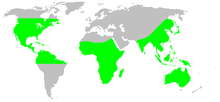Wandering spider
| Wandering spiders | |
|---|---|
 |
|
| Phoneutria nigriventer | |
| Scientific classification | |
| Kingdom: | Animalia |
| Phylum: | Arthropoda |
| Subphylum: | Chelicerata |
| Class: | Arachnida |
| Order: | Araneae |
| Infraorder: | Araneomorphae |
| Family: |
Ctenidae Keyserling, 1877 |
| Genera | |
|
see text |
|
| Diversity | |
| 41 genera, 503 species | |
 |
|
see text
The wandering spiders are the members of the spider family Ctenidae. Some mistakenly misinterpret the name to only mean the genus Phoneutria, which are often called Brazilian wandering spiders (despite several species with ranges outside of Brazil), but wandering spiders better refers to the entire family Ctenidae. The members of the genus Phoneutria are highly aggressive and venomous nocturnal hunters, and are the only wandering spiders known to pose potential danger to humans. However, the venoms of many other members of this family are very poorly known, meaning that all larger ctenids should be treated with caution. Some ctenids have marks and patterns that are attractive. Ctenids have a distinctive longitudinal groove on the top-rear of their oval carapace (some other spiders have a similar groove; e.g., Amaurobiidae).
As of March 2017[update], the World Spider Catalog accepted the following genera:
...
Wikipedia
